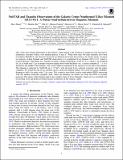Notice
This is not the latest version of this item. The latest version can be found at:https://dspace.mit.edu/handle/1721.1/132365.2
NuSTAR and Chandra Observations of the Galactic Center Nonthermal X-Ray Filament G0.13–0.11: A Pulsar-wind-nebula-driven Magnetic Filament
| dc.contributor.author | Zhang, Shuo | |
| dc.contributor.author | Zhu, Zhenlin | |
| dc.contributor.author | Li, Hui | |
| dc.contributor.author | Pasham, Dheeraj | |
| dc.contributor.author | Li, Zhiyuan | |
| dc.contributor.author | Clavel, Maïca | |
| dc.contributor.author | Baganoff, Frederick K | |
| dc.contributor.author | Perez, Kerstin | |
| dc.contributor.author | Mori, Kaya | |
| dc.contributor.author | Hailey, Charles J | |
| dc.date.accessioned | 2021-09-20T18:22:04Z | |
| dc.date.available | 2021-09-20T18:22:04Z | |
| dc.identifier.uri | https://hdl.handle.net/1721.1/132365 | |
| dc.description.abstract | © 2020. The American Astronomical Society. All rights reserved. One of the most unique phenomena in the Galactic center region is the existence of numerous long and narrow filamentary structures within a few hundred parsecs of Sgr A∗. While more than 100 radio filaments have been revealed by MeerKAT, only about two dozen X-ray filaments have been discovered so far. In this article, we report our analysis of deep Chandra and NuSTAR observations of a nonthermal X-ray filament, G0.13-0.11, which is located adjacent to the Radio Arc. Chandra revealed a unique morphology of G0.13-0.11, which is an elongated (0.1 pc in width and 3.2 pc in length) structure slightly bent toward the Radio Arc. A pulsar candidate (Γ ∼ 1.4) is detected in the middle of the filament, with a tail of diffuse nonthermal X-ray emission on one side of the filament. The filament is detected by NuSTAR up to 79 keV, with the hard X-ray centroid consistent with the pulsar candidate. We found that the X-ray intensity decays along the filament farther away from the pulsar candidate, dropping to half of its peak value 2.2 pc away. This system is most likely a pulsar wind nebula (PWN) interacting with the ambient interstellar magnetic field, where the filaments are kinetic jets from the PWN as recently proposed. The nature of this filament adds to the complex origin of X-ray filaments, which serve as powerful tools for probing local and global powerful particle accelerators in the Galactic center. | en_US |
| dc.language.iso | en | |
| dc.publisher | American Astronomical Society | en_US |
| dc.relation.isversionof | 10.3847/1538-4357/AB7DC1 | en_US |
| dc.rights | Article is made available in accordance with the publisher's policy and may be subject to US copyright law. Please refer to the publisher's site for terms of use. | en_US |
| dc.source | The American Astronomical Society | en_US |
| dc.title | NuSTAR and Chandra Observations of the Galactic Center Nonthermal X-Ray Filament G0.13–0.11: A Pulsar-wind-nebula-driven Magnetic Filament | en_US |
| dc.type | Article | en_US |
| dc.relation.journal | Astrophysical Journal | en_US |
| dc.eprint.version | Final published version | en_US |
| dc.type.uri | http://purl.org/eprint/type/JournalArticle | en_US |
| eprint.status | http://purl.org/eprint/status/PeerReviewed | en_US |
| dc.date.updated | 2020-11-09T15:33:04Z | |
| dspace.orderedauthors | Zhang, S; Zhu, Z; Li, H; Pasham, D; Li, Z; Clavel, M; Baganoff, FK; Perez, K; Mori, K; Hailey, CJ | en_US |
| dspace.date.submission | 2020-11-09T15:33:10Z | |
| mit.journal.volume | 893 | en_US |
| mit.journal.issue | 1 | en_US |
| mit.license | PUBLISHER_POLICY | |
| mit.metadata.status | Authority Work and Publication Information Needed |
